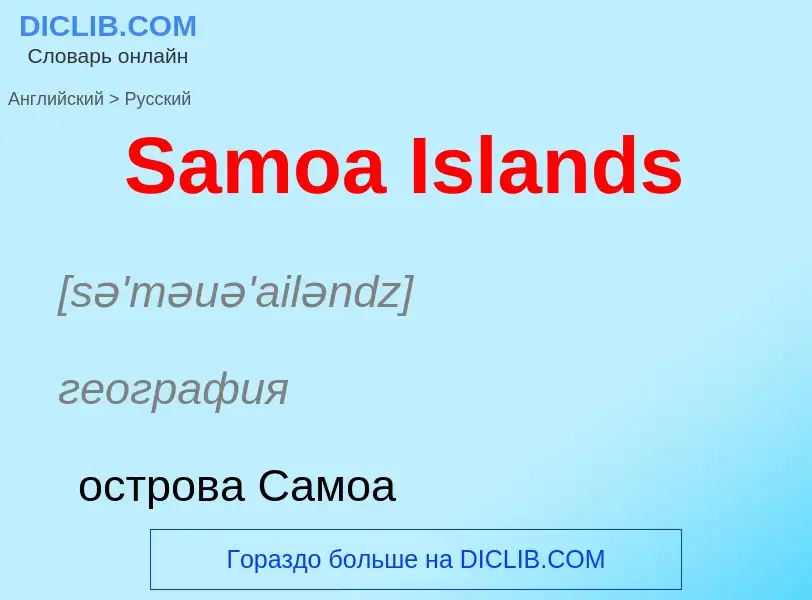Перевод и анализ слов искусственным интеллектом ChatGPT
На этой странице Вы можете получить подробный анализ слова или словосочетания, произведенный с помощью лучшей на сегодняшний день технологии искусственного интеллекта:
- как употребляется слово
- частота употребления
- используется оно чаще в устной или письменной речи
- варианты перевода слова
- примеры употребления (несколько фраз с переводом)
- этимология
Samoa Islands - перевод на русский
[sə'məuə'ailəndz]
география
острова Самоа
['i:stənsə'məuə]
география
Восточное Самоа
[kə'mɑ:ndə(r)'ailəndz]
синоним
синоним
существительное
общая лексика
Курильские острова
синоним
[ri'ju:kju:'ailəndz]
география
архипелаг Рюкю
['ɑ:ru:'ailəndz]
география
острова Ару
Определение
Википедия

The Samoan Islands (Samoan: Motu o Sāmoa) are an archipelago covering 3,030 km2 (1,170 sq mi) in the central South Pacific, forming part of Polynesia and of the wider region of Oceania. Administratively, the archipelago comprises all of the Independent State of Samoa and most of American Samoa (apart from Swains Island, which is geographically part of the Tokelau Islands). The land masses of the two Samoan jurisdictions are separated by 64 km (40 mi) of ocean at their closest points.
The population of the Samoan Islands is approximately 250,000. The inhabitants have in common the Samoan language, a culture known as fa'a Samoa, and an indigenous form of governance called fa'amatai. Samoans are one of the largest Polynesian populations in the world, and most are of exclusively Samoan ancestry.
The oldest known evidence of human activity in the Samoan Islands dates to around 1050 BCE. It comes from a Lapita site at Mulifanua wharf on Upolu island. In 1768, the eastern islands were visited by the French explorer Bougainville, who named them the Navigator Islands. That name was used by missionaries until about 1845, and in official European dispatches until about 1870.


![Thomas Andrew]]) Thomas Andrew]])](https://commons.wikimedia.org/wiki/Special:FilePath/A Manaia, son of a Samoan matai photo Andrew.Thomas.jpg?width=200)
![German, British and American warships in [[Apia]] harbour, 1899. German, British and American warships in [[Apia]] harbour, 1899.](https://commons.wikimedia.org/wiki/Special:FilePath/German, British, American warships in Apia harbour, Samoa 1899.jpg?width=200)
![[[Tonga Trench]] south of the Samoa Islands and north of [[New Zealand]]. [[Tonga Trench]] south of the Samoa Islands and north of [[New Zealand]].](https://commons.wikimedia.org/wiki/Special:FilePath/Kermadec Arc.jpg?width=200)


![[[Mt Matavanu]] volcanic eruption on [[Savai'i]] island, 1905 [[Mt Matavanu]] volcanic eruption on [[Savai'i]] island, 1905](https://commons.wikimedia.org/wiki/Special:FilePath/Volcano eruption Mt Matavanu - Savai'i - 1905 - photo by Thomas Andrew.jpg?width=200)
![Afono]] village, [[Tutuila]] island, American Samoa. Afono]] village, [[Tutuila]] island, American Samoa.](https://commons.wikimedia.org/wiki/Special:FilePath/Afono Village NPS.jpg?width=200)
![[[Aunu'u]] island, offshore of the island of Tutuila, American Samoa [[Aunu'u]] island, offshore of the island of Tutuila, American Samoa](https://commons.wikimedia.org/wiki/Special:FilePath/Aunu'u Island National National Landmark.jpg?width=200)
![A beach on [[Ofu-Olosega]], a volcanic doublet in the Manu'a Group of islands. A beach on [[Ofu-Olosega]], a volcanic doublet in the Manu'a Group of islands.](https://commons.wikimedia.org/wiki/Special:FilePath/1farleftpalms.jpg?width=200)
![Fuipisia waterfall in [[Lotofaga]], Upolu island. Fuipisia waterfall in [[Lotofaga]], Upolu island.](https://commons.wikimedia.org/wiki/Special:FilePath/Fuipisia waterfall - Samoa.jpg?width=200)

![Bering's]] second voyage and the discovery of the Commander Islands Bering's]] second voyage and the discovery of the Commander Islands](https://commons.wikimedia.org/wiki/Special:FilePath/1966 CPA 3446.jpg?width=200)
![Aleut]] hunters from [[Bering Island]] ({{circa}} 1884–1886) Aleut]] hunters from [[Bering Island]] ({{circa}} 1884–1886)](https://commons.wikimedia.org/wiki/Special:FilePath/Bering Island Aleuts.jpg?width=200)
![Bering expedition]] member S. Khitrov of eastern Kamchatka, including the Commander Islands, with drawings of [[Steller's sea cow]], the [[northern fur seal]] and the [[Steller sea lion]]. Bering expedition]] member S. Khitrov of eastern Kamchatka, including the Commander Islands, with drawings of [[Steller's sea cow]], the [[northern fur seal]] and the [[Steller sea lion]].](https://commons.wikimedia.org/wiki/Special:FilePath/Chitrow - Seekuh, Seebaer und Seeloewe (Ausschnitt aus einer Karte).jpg?width=200)



![[[Severo-Kurilsk]], Paramushir [[Severo-Kurilsk]], Paramushir](https://commons.wikimedia.org/wiki/Special:FilePath/214 1426 Sev Kur main street wiki.jpg?width=200)

![U.S. Army Map Service]] maps compiled in the early 1950s U.S. Army Map Service]] maps compiled in the early 1950s](https://commons.wikimedia.org/wiki/Special:FilePath/Composite island map, from Series L506, U.S. Army Map Service, 1954-.jpg?width=200)
![Ainu]] Ainu]]](https://commons.wikimedia.org/wiki/Special:FilePath/Historical expanse of Ainu.png?width=200)


.jpg?width=200)

![5 rouble]] coin, 2020. 5 rouble]] coin, 2020.](https://commons.wikimedia.org/wiki/Special:FilePath/RR5712-0051R 5 рублей 2020 реверс сталь 75-летие Курильской десантной операции.png?width=200)
![[[Caldera]] of the island [[Ushishir]] [[Caldera]] of the island [[Ushishir]]](https://commons.wikimedia.org/wiki/Special:FilePath/Yankicha.jpg?width=200)
![[[Yuzhno-Kurilsk]], Kunashir [[Yuzhno-Kurilsk]], Kunashir](https://commons.wikimedia.org/wiki/Special:FilePath/Yuzhno-Kurilsk anchor.jpg?width=200)

![[[Stratovolcano]] Mt. Ruruy; view from [[Yuzhno-Kurilsk]] [[Stratovolcano]] Mt. Ruruy; view from [[Yuzhno-Kurilsk]]](https://commons.wikimedia.org/wiki/Special:FilePath/Вулкан Руруй (с Южно-Курильска).jpg?width=200)
![[[Mendeleyeva]] in the southern part of Kunashir [[Mendeleyeva]] in the southern part of Kunashir](https://commons.wikimedia.org/wiki/Special:FilePath/Вулкан Тятя с вулкана Менделеева.jpg?width=200)

![[[Ebeko]] volcano, Paramushir [[Ebeko]] volcano, Paramushir](https://commons.wikimedia.org/wiki/Special:FilePath/Стратовулкан.jpg?width=200)
![Main village in [[Shikotan]] Main village in [[Shikotan]]](https://commons.wikimedia.org/wiki/Special:FilePath/Шикотан 008.jpg?width=200)

![The last [[sunset]] in Japan is seen from [[Yonaguni]]. The last [[sunset]] in Japan is seen from [[Yonaguni]].](https://commons.wikimedia.org/wiki/Special:FilePath/Lastsunsetjapan.jpg?width=200)
![Miyakojima]], [[Okinawa Prefecture]] Miyakojima]], [[Okinawa Prefecture]]](https://commons.wikimedia.org/wiki/Special:FilePath/Miyako harimizu utaki.jpg?width=200)


![Tanegashima]] [[matchlock]] Tanegashima]] [[matchlock]]](https://commons.wikimedia.org/wiki/Special:FilePath/TanegashimaGun.jpg?width=200)
![The [[Yonaguni Monument]], a rock formation along the south coast of [[Yonaguni Island]] The [[Yonaguni Monument]], a rock formation along the south coast of [[Yonaguni Island]]](https://commons.wikimedia.org/wiki/Special:FilePath/Yonaguni Ruins Scuba.jpg?width=200)
.jpg?width=200)




![Inhabitants of the eastern coast of the Aru Islands, photographed late 1899 during the [[Siboga Expedition]]. Inhabitants of the eastern coast of the Aru Islands, photographed late 1899 during the [[Siboga Expedition]].](https://commons.wikimedia.org/wiki/Special:FilePath/UvA-BC 300.146 - Siboga - Arunezen op het dek van de Siboga.jpg?width=200)
